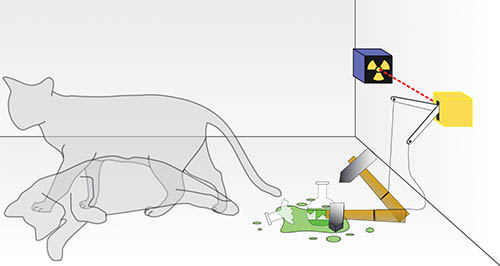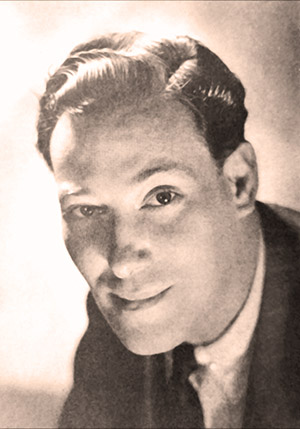Is There a Connection Between
Quantum Physics & Positive Thinking?
For the last several years a thickening stream of New Age books and documentaries have, to the chagrin of critics, attempted to use quantum theory to “prove” that the mind possesses causative powers. Enthusiasts say that quantum experiments demonstrate that an observer’s presence or perspective determines the nature of objects on a subatomic scale.
Recently Robert Lanza, adjunct professor at the Institute for Regenerative Medicine at Wake Forest University, argued that death itself is ultimately a mental phenomenon – we “die” because the mind perceives demise.1
Researchers are rightly vexed when concepts in quantum theory are picked over in slipshod or sensationalistic ways. Most scientists want to slam shut the door on this (admittedly dim) connection between quantum physics and the vaunted reality-shaping properties of the mind. But ongoing findings in quantum physics – when considered without half-baked understanding – keep pushing the door back open.
There is place for a conversation between physicists and serious people in the metaphysical culture – including those who are interested in the widely maligned practice of “positive thinking,” which holds that thoughts influence reality. Scientific authorities quickly shoot down the starting proposition that quantum theory raises a viable question about the causative influence of the mind, at least in a world of subatomic particles and waves. Many scientists object that such notions arise from a misunderstanding of quantum data.
Yet, if approached with care, this discussion – of whether observation evinces causal properties in a world of waves and particles – deserves the ear of reasonable people.
First the basics: Physics journals today routinely discuss what is called the “quantum measurement problem.” Many people have heard of some version of it. In essence, more than eighty years of laboratory experiments show that atomic-scale particles appear in a given place only when a measurement is made. Astonishing as it sounds – and physicists themselves have debated the data for generations – quantum theory holds that no measurement means no precise and localised object on the atomic level.
Put differently, a subatomic particle literally occupies an infinite number of places (a state called “superposition”) until observation manifests it in one place. In quantum mechanics, a decision to look or not look actually determines what will be there. In this sense, an observer’s consciousness determines objective reality in the subatomic field.
Some physicists would dispute that characterisation. Critics sometimes argue that certain particles are too small to measure; hence any attempt at measurement inevitably affects what is seen. But there exists a whole class of “interaction-free measurement” quantum experiments that don’t involve detectors at all. Such experiments have repeatedly shown that a subatomic object literally exists in more than one place at once until a measurement determines its final resting place.
How is this actually provable? In the parlance of quantum physics, an atomic-scale particle is said to exist in a wave-state, which means that the location of the particle in space-time is known only probabilistically; it has no properties in this state, just potentialities. When particles or waves – typically in the form of a beam of photons or electrons – are directed or aimed at a target system, such as a double-slit, scientists have found that their pattern or path will actually change, or “collapse,” depending upon the presence or measurement choices of an observer. Hence, a wave pattern will shift, or collapse, into a particle pattern. Contrary to all reason, quantum theory holds that opposing outcomes simultaneously exist.
The situation gets even stranger when dealing with the thought experiment known as “Schrodinger’s Cat.” The twentieth-century physicist Erwin Schrodinger was frustrated with the evident absurdity of quantum theory which showed objects simultaneously appearing in more than one place at a time. Such an outlook, he felt, violated all commonly observed physical laws. In 1935, Schrodinger sought to highlight this predicament through a purposely absurdist thought experiment, which he intended to force quantum physicists to follow their data to its ultimate degree.
Schrodinger reasoned that quantum data dictates that a sentient being, such as a cat, can be simultaneously alive and dead. A variant of the Schrodinger’s Cat experiment could be put this way: Let’s say a cat is placed into one of a pair of boxes. Along with the cat is what Schrodinger called a “diabolical device.” The device, if exposed to an atom, releases a deadly poison. An observer then fires an atom at the boxes. The observer subsequently uses some form of measurement to check on which box the atom is in: the empty one, or the one with the cat and the poisoning device. When the observer goes to check, the wave function of the atom – i.e., the state in which it exists in both boxes – collapses into a particle function – i.e., the state in which it is localised to one box. Once the observer takes his measurement, convention says that the cat will be discovered to be dead or alive. But Schrodinger reasoned that quantum physics describes an outcome in which the cat is both dead and alive. This is because the atom, in its wave function, was, at one time, in either box, and either outcome is real.

Of course, all lived experience tells us that if the atom went into the empty box, the cat is alive; and if it went into the box with the cat and the poisoning device, the cat is dead. But Schrodinger, aiming to highlight the frustrations of quantum theory, argued that if the observations of quantum-mechanics experiments are right you would have to allow for each outcome.
To take it even further, a cohort of quantum physicists in the 1950s theorised that if an observer waited some significant length of time, say, eight hours, before checking on the dead-alive cat, he would discover one cat that was dead for eight hours and another that was alive for eight hours (and now hungry). In this line of reasoning, conscious observation effectively manifested the localised atom, the dead cat, the living cat – and also manifested the past, i.e., created a history for both a dead cat and a living one. Both outcomes are true.
Absurd? Impossible? Yes to that, say quantum physicists – but decades of quantum experiments make this model – in which a creature can be dead/alive – into an impossible reality: an unbelievable yet entirely tenable, even necessary, state of nature. Schrodinger’s thought experiment forced a consideration of the meaning of quantum mechanics (though not many physicists pay attention to the radical implications).
Why is there an apparent divide in our view of reality, in which one set of rules governs the events of the micro world and another set governs the macro world? It may be due to the limits of our observation in the macro world. Some twenty-first-century quantum physicists call this phenomenon “information leakage.”
The theory of “information leakage” holds that the apparent impossibilities of quantum activity exist all around us. They govern reality. However, when we step away from whatever instrument we are using to measure micro particles and begin looking at things in larger frames and forms, we see less and less of what is really going on. We experience a “leakage” of data. William James alluded to a similar dynamic in his 1902 Gifford Lectures: “We learn most about a thing when we view it under a microscope, as it were, or in its most exaggerated form. This is as true of religious phenomena as of any other kind of fact.”
Only future experiments will determine the broader implications of sub-natural phenomena in the mechanical one in which we live. For now, however, decades of quantum data make it defensible to conclude that observation done on the subatomic scale: (1) shapes the nature of outcomes, (2) determines the presence or absence of a localised object, and (3) possibly devises multiple pasts and presents. This last point is sometimes called the “many-worlds interpretation,” in the words of physicist Hugh Everett. This theory of “many worlds” raises the prospect of an infinite number of realities and states of being, each depending upon our choices. And here we encounter the frustrating but persistent thesis of positive thinking, which holds, in some greater or lesser measure, that our thoughts influence – concretely – our experience.
Everett’s concept of multiple worlds and outcomes based on the vantage point of the observer finds its closest metaphysical analogue in the ideas of Neville Goddard,2 a mid-twentieth century mystical writer and lecturer who reasoned that our thoughts create an infinitude of realities and outcomes. Neville (who went by his first name) argued that everything we see and experience, including one another, is the product of what happens in our own individual dream of reality. Through a combination of emotional conviction and mental images, Neville believed, each person imagines his own world into being – all people and events are rooted in us, as we are ultimately rooted in God. When a person awakens to his true self, Neville argued, he will, in fact, discover himself to be a slumbering branch of the Creator clothed in human form, and at the helm of infinite possibilities.
Most quantum physicists wouldn’t be caught dead/alive as Schrodinger’s cat reading an occult philosopher such as Neville. Indeed, many physicists reject the notion of interpreting the larger implications of quantum data at all. “Shut up and calculate!” is the battle cry popularised by physicist N. David Mermin. The role of physics, critics insist, is to measure things – not, in Einstein’s phrase, to lift “the veil that shrouds the Old One.” Leave that to gurus and philosophers, but, for heaven’s sake, critics argue, keep it out of the physics lab. Others adopt the opposite position: If physics isn’t for explaining reality, then what is it for?
The latter principle may carry the day. A rising generation of physicists, educated in the sixties and seventies and open to questions of consciousness, is currently reaching positions of leadership in physics departments (and gaining authority in areas of grant-making and funding). This cohort was educated in a world populated by Zen and motorcycle maintenance, psychedelic experimentation, and Star Trek; they tend to be open to philosophical questions and meta-analysis. As scientists they are every bit as rigorous as the past generation of classical empiricists. Hence, we could be on the brink of a renaissance of inquiry into the most remarkable scientific issue since Newton codified classical mechanics. As more data is known, purveyors of quantum physics and metaphysics may be headed for a new and serious conversation.
But the pitfalls are too important not to consider before waltzing off into the world of “both/and” realities. To the frustration of scientists, spiritual seekers often prove overeager to seize upon the implications of quantum data, declaring that we now have proof that the universe is the result of our minds. The correlation between the events of the micro world and those of the daily life that we see and feel is far from clear. Spiritual seekers should resist the temptation to cherry-pick from data that seems to confirm their most deeply cherished ideas. Likewise, physicists should be patient with lay seekers who want to ponder the possibilities of quantum physics. If the right balance can be struck, serious and thoughtful people from both worlds, science and spirituality, have something to talk over. Such a discussion may, ultimately, revolutionise how we see ourselves in the twenty-first century as much as Darwinism did in the Victorian age.
Footnotes
1. Does Death Exist? New Theory Says ‘No’ by Robert Lanza, M.D., www.huffpost.com/entry/does-death-exist-new-theo_b_384515
2. The Greatest Philosopher You’ve Never Heard Of by Mitch Horowitz, https://
medium.com/universal-quest/the-greatest-philosopher-youve-never-heard-of-336231e26885
© New Dawn Magazine and the respective author.
For our reproduction notice, click here.



